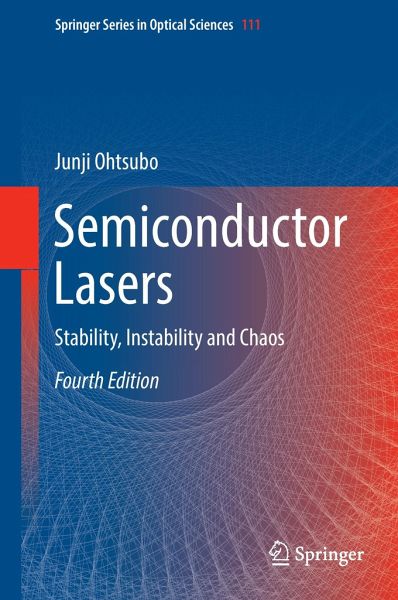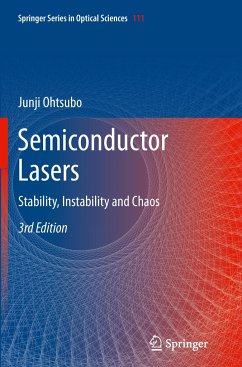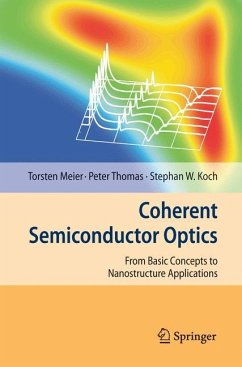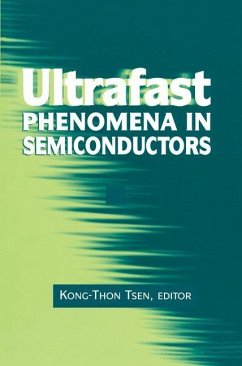
Semiconductor Lasers
Stability, Instability and Chaos
Versandkostenfrei!
Versandfertig in 6-10 Tagen
190,99 €
inkl. MwSt.
Weitere Ausgaben:

PAYBACK Punkte
95 °P sammeln!
This book describes the fascinating recent advances made concerning the chaos, stability and instability of semiconductor lasers, and discusses their applications and future prospects in detail. It emphasizes the dynamics in semiconductor lasers by optical and electronic feedback, optical injection, and injection current modulation. Applications of semiconductor laser chaos, control and noise, and semiconductor lasers are also demonstrated.Semiconductor lasers with new structures, such as vertical-cavity surface-emitting lasers and broad-area semiconductor lasers, are intriguing and promising ...
This book describes the fascinating recent advances made concerning the chaos, stability and instability of semiconductor lasers, and discusses their applications and future prospects in detail. It emphasizes the dynamics in semiconductor lasers by optical and electronic feedback, optical injection, and injection current modulation. Applications of semiconductor laser chaos, control and noise, and semiconductor lasers are also demonstrated.
Semiconductor lasers with new structures, such as vertical-cavity surface-emitting lasers and broad-area semiconductor lasers, are intriguing and promising devices. Current topics include fast physical number generation using chaotic semiconductor lasers for secure communication, development of chaos, quantum-dot semiconductor lasers and quantum-cascade semiconductor lasers, and vertical-cavity surface-emitting lasers.
This fourth edition has been significantly expanded to reflect the latest developments. The fundamental theory oflaser chaos and the chaotic dynamics in semiconductor lasers are discussed, but also for example the method of self-mixing interferometry in quantum-cascade lasers, which is indispensable in practical applications.
Further, this edition covers chaos synchronization between two lasers and the application to secure optical communications. Another new topic is the consistency and synchronization property of many coupled semiconductor lasers in connection with the analogy of the dynamics between synaptic neurons and chaotic semiconductor lasers, which are compatible nonlinear dynamic elements. In particular, zero-lag synchronization between distant neurons plays a crucial role for information processing in the brain. Lastly, the book presents an application of the consistency and synchronization property in chaotic semiconductor lasers, namely a type of neuro-inspired information processing referred to as reservoir computing.
Semiconductor lasers with new structures, such as vertical-cavity surface-emitting lasers and broad-area semiconductor lasers, are intriguing and promising devices. Current topics include fast physical number generation using chaotic semiconductor lasers for secure communication, development of chaos, quantum-dot semiconductor lasers and quantum-cascade semiconductor lasers, and vertical-cavity surface-emitting lasers.
This fourth edition has been significantly expanded to reflect the latest developments. The fundamental theory oflaser chaos and the chaotic dynamics in semiconductor lasers are discussed, but also for example the method of self-mixing interferometry in quantum-cascade lasers, which is indispensable in practical applications.
Further, this edition covers chaos synchronization between two lasers and the application to secure optical communications. Another new topic is the consistency and synchronization property of many coupled semiconductor lasers in connection with the analogy of the dynamics between synaptic neurons and chaotic semiconductor lasers, which are compatible nonlinear dynamic elements. In particular, zero-lag synchronization between distant neurons plays a crucial role for information processing in the brain. Lastly, the book presents an application of the consistency and synchronization property in chaotic semiconductor lasers, namely a type of neuro-inspired information processing referred to as reservoir computing.














